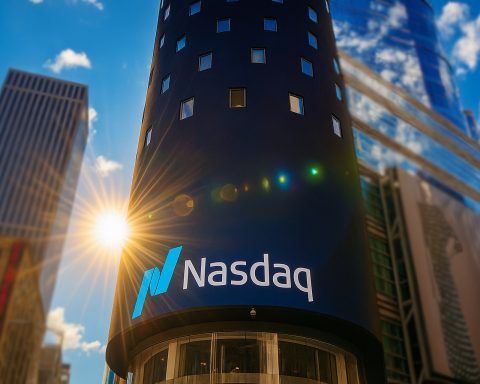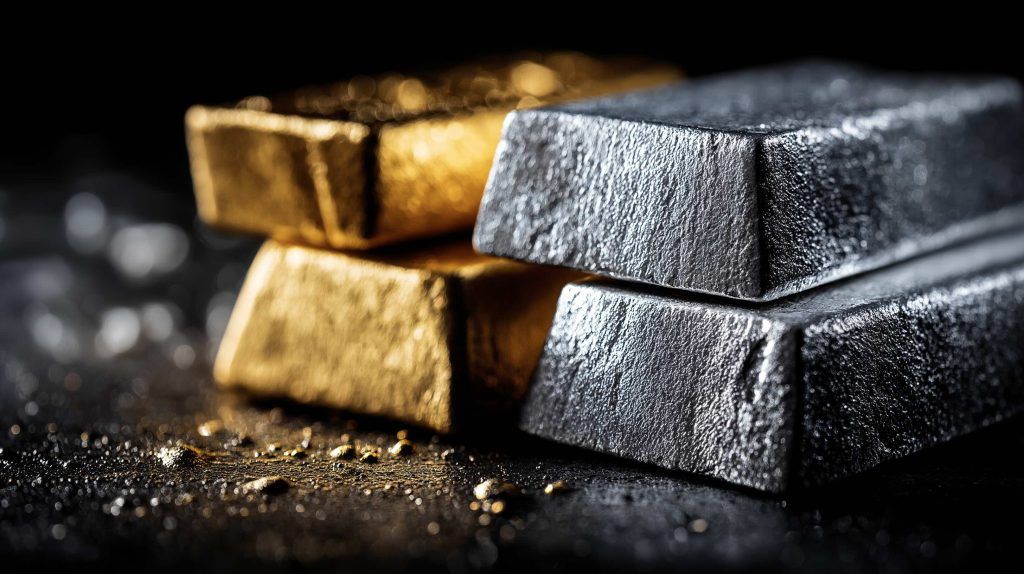- Record-breaking rally: Gold prices have surged to all-time highs near $3,900 per ounce in early October 2025, up roughly 45–48% year-to-date – on track for the strongest annual gain since 1979 [1] [2]. The metal hit ~$3,896/oz this week, hovering just shy of the psychological $4,000 mark [3], after seven straight weekly gains.
- Safe-haven demand: A perfect storm of inflation fears, interest rate pivot bets, geopolitical turmoil, and dollar weakness is driving investors into gold as a safe haven [4] [5]. Central banks are also gobbling up gold reserves at a record pace, adding a powerful tailwind [6] [7].
- Fed rate cuts on deck: Markets are pricing in imminent Federal Reserve rate cuts (97% odds of an October cut) amid cooling economic data [8]. Lower rates and falling bond yields boost gold’s appeal by reducing the opportunity cost of holding non-yielding assets [9]. “As we anticipate further rate cuts, this should support the gold price… looking for the yellow metal to breach the $4,000/oz mark by the end of this year,” says UBS analyst Giovanni Staunovo [10].
- Geopolitical and fiscal jitters:Global tensions and U.S. political strife are stoking uncertainty. Investors are reacting to Russia-NATO friction and a U.S. government shutdown, as well as concerns over U.S. fiscal deficits and trade wars [11] [12]. This “broader de-dollarization trend” has weakened the U.S. dollar (down ~9% in 2025) and “caused angst in markets,” one fund manager notes – a big reason gold has become the safe-haven of choice [13].
- Bullish forecasts – with a caveat: Many analysts see more upside ahead. Several major banks now project gold above $4,000 in the coming months [14] [15], and some even suggest it could reach $5,000 under certain conditions [16]. However, near-term overheating is a risk. Experts caution that gold looks “tactically overbought” after its meteoric rise [17], raising the odds of a pullback (possibly toward ~$3,500) before the uptrend resumes [18].
Recent Record Run: Gold Nears $4,000
Gold’s bull run has accelerated dramatically in late 2025. This past week, the metal notched its seventh consecutive weekly gain, briefly touching a record $3,896.49/oz on Thursday [19]. As of October 5, spot gold hovers around $3,860–$3,880, just shy of the once-unthinkable $4k level [20]. U.S. gold futures have followed suit, trading near $3,884 for December delivery [21]. In just the first week of October, prices climbed over 3%, capping an explosive multi-month rally. Gold has now surged roughly 47–48% since January [22], vastly outperforming stocks and other commodities and marking the best year for gold since 1979 [23]. Back in 1979 – an era of runaway inflation and geopolitical crisis – gold famously jumped 126% in a single year [24]. Four and a half decades later, 2025’s rally is rewriting the record books with a similar mix of economic anxiety and safe-haven fever.
What sparked the latest price spike? In recent days, one catalyst has been U.S. political gridlock. A budget impasse in Washington led to a partial government shutdown at the start of Q4, amplifying fears of economic fallout [25] [26]. “I think the longer the government stays shut down, that’s going to be a steady bullish element for the gold market,” explains Jim Wyckoff, senior analyst at Kitco Metals [27]. Indeed, on news of the prolonged shutdown and the delay of key economic reports (like the jobs data), gold pushed to fresh highs [28]. Analysts say investors are flocking to safety, driving bullion’s relentless bid. “Gold prices have left another upbeat week behind,” Daily Sabah notes, “as fresh concerns over the U.S. government shutdown boosted the precious metal” [29]. Combined with other factors discussed below, this has created a perfect gold-friendly environment.
Market sentiment is clearly bullish in the near term. Traders and forecasters widely expect the $4,000 barrier to fall soon. “Analysts and brokerages expect the prices could easily hit $4,000 as uncertainties originating from the U.S. bolster the appeal of [gold] as one of the top safe havens,” reports one market review [30]. In fact, some strategists think gold could overshoot that round number imminently. “Gold’s bull market remains firmly intact in early October 2025,” writes veteran commodities analyst Andrew Hecht, noting that many believe gold could reach $4,000 “or higher over the coming weeks and months.” But Hecht also adds a note of caution: “However, the higher the price rises, the greater the risk of a correction” [31]. This encapsulates the current tug-of-war between momentum and caution as gold flirts with $4k – enthusiasm for the rally’s drivers versus awareness that parabolic moves can invite pullbacks.
Why Gold Is Soaring: Key Drivers in 2025
Inflation, interest rates, and recession fears – these traditional gold drivers are all flashing green for bullion. After aggressive rate hikes in prior years, the U.S. Federal Reserve has shifted tone as economic data softens. Investors now anticipate rate cuts in the coming months, which is hugely supportive for gold prices [32]. According to CME FedWatch data, markets are pricing in a 97% probability of a Fed rate reduction in October 2025, and around 85–88% odds of another cut in December [33]. Such expectations have been bolstered by signs of a cooling labor market – for example, recent payrolls growth came in far below forecasts, and some months even saw net job losses after revisions [34]. Inflation, while off its peak, is still hovering above central bank targets (U.S. CPI is ~2.7% annually in the latest reports [35]). This gives the Fed room to ease policy to support growth, but also keeps inflation anxiety alive. Lower interest rates are music to gold investors’ ears: when cash and bonds yield less, the opportunity cost of holding gold drops, making the metal more attractive [36]. “The data suggests the Fed should cut rates,” notes UBS’s Giovanni Staunovo, “and as we anticipate further rate cuts, this should support the gold price further… breach the $4,000/oz mark by the end of this year” [37]. In essence, the market is betting that a dovish pivot by central banks will unleash even more demand for zero-yield, inflation-resistant assets like gold. Bullion historically thrives in low-rate environments, especially when real (inflation-adjusted) rates are low or negative [38] [39].
Geopolitical and economic uncertainties are the second major pillar of 2025’s gold boom. Gold is the classic “haven” asset when the world looks risky, and lately there’s no shortage of risks. 2025 has seen escalating geopolitical tensions, notably the protracted war in Ukraine and heightened frictions between Russia and NATO [40]. Investors are jittery over the possibility of broader conflict or new flashpoints, and gold’s status as a crisis hedge is burnished with each headline of turmoil. Simultaneously, political turbulence in the United States – the world’s largest economy – has sown uncertainty in financial markets. Beyond the aforementioned government shutdown (the first in years), there’s been fierce debate over monetary policy independence and trade. Analysts point to “increased rhetoric against the Fed and its independence from the Trump administration” leading to concerns about U.S. dollar stability and the Treasuries market [41]. In fact, 2025 has seen the return of trade war fears and protectionist policies, with U.S. tariffs climbing to their highest level since the 1930s in a revival of economic nationalism [42]. “Overall, markets have not been badly hit by the jump in U.S. tariffs this year… But the most obvious vehicle of trade war worry has been the U.S. dollar,” The Guardian explains [43].
All this feeds a narrative of waning confidence in the dollar and U.S. assets, which plays directly into gold’s hands. Eva Sun-Wai, a fund manager at M&G, describes a “broader de-dollarization trend” unfolding as global investors react to U.S. political moves [44]. This has “caused angst in markets,” she says, and is “a big reason why gold… has become the safe haven choice” when investors are reluctant to hold dollars or U.S. bonds [45]. The numbers bear this out: the U.S. Dollar Index is enduring a “bruising 2025” – down more than 9% so far this year [46]. A weaker dollar directly boosts gold’s USD price (since gold is globally traded in dollars), and it also encourages central banks and investors to rebalance reserves toward gold [47] [48]. As one analyst succinctly put it, “interest rates, inflation and geopolitical crises” have aligned to give gold its strongest performance in decades [49]. In such an environment fraught with policy uncertainty, inflation concerns and, now, a U.S. government shutdown, investors naturally turn to precious metals – and that’s been “particularly true in 2025” [50].
Central bank actions form the third key driver of gold’s ascent. In addition to adjusting interest rates, central banks (especially in emerging markets) have been massive net buyers of gold for several years – a trend that continues to accelerate. Gold’s appeal to central banks is as a long-term store of value and alternative reserve asset when they want to diversify away from the U.S. dollar. Notably, China has been steadily accumulating gold and even aims to become a custodian for other countries’ gold reserves, as part of a strategy to strengthen its influence in the global bullion market while reducing reliance on Western financial centers [51]. “Central banks have also been adding to their gold reserves in recent years. Notably China,” The Guardian reports, citing this move as an attempt to lessen dependence on the dollar [52]. This year, such official sector demand has provided a firm underpinning for prices. Ole Hansen, head of commodity strategy at Saxo Bank, observes that gold’s rise in 2025 has been “fundamentally supported by increased demand from central banks”, with both individual and institutional investors “increasingly turning to gold” as well [53]. In other words, it’s not just fear-driven retail buying; deep-pocketed institutions and national treasuries are bidding up gold as a strategic asset. Concerns about ballooning government deficits and high debt levels are adding fuel to this trend [54]. When investors worry that governments may overstretch finances or even “lose their grip on public finances,” hard assets like gold start to look very attractive as a form of monetary insurance [55]. As Stephen Innes of SPI Asset Management memorably explains, gold’s supply is naturally limited – “no policy, no discovery, no quantitative easing of geology can debase gold” – making it a robust hedge when confidence in fiat currencies falters [56].
Technical Analysis: Overbought, or More Room to Run?
From a technical perspective, gold’s chart has been as remarkable as its fundamental backdrop. The metal decisively broke out above its previous ceiling (~$2,075 from 2020’s peak) and never looked back, entering what analysts call an “accelerated uptrend” since late 2023 [57]. The momentum only grew in 2025 – a nearly 50% price surge this year, which one strategist notes is “the strongest annual gain since 1979” [58]. This steep climb has delivered repeated all-time highs throughout the year [59], and in the last month alone gold jumped almost 10% as the U.S. budget showdown loomed [60]. However, such torrid gains have also pushed short-term technical indicators into extreme territory. FX Empire’s cycle model, for instance, shows gold nearing “maximum cycle topping conditions,” signaling that an “intermediate peak is becoming likely” [61]. In plainer terms, gold looks overbought by historical standards – something also flagged by analysts at Bank of America, who caution that gold is tactically “overbought” right now (even as they argue it remains under-owned in portfolios longer-term) [62].
Chartists are eyeing key resistance levels as gold approaches the $4,000 milestone. The current price sits near the upper boundary of its rising trend channel, suggesting the rally could be due for a breather [63]. A short-term “blowoff” rally isn’t out of the question – some foresee a final spike above ~$4,100 if buying climaxes, which would mark the top of the channel [64]. But few expect a sustained break well beyond $4,200 in the immediate term [65]. Instead, once this uptrend’s intermediate cycle peaks, analysts anticipate a healthy correction or consolidation phase. One forecast envisions a pullback to around the $3,500 level (roughly a 10% retracement from recent highs) followed by a multi-month period of sideways trading to digest the gains [66]. Such a move could reset overbought conditions and potentially set the stage for the next leg up.
Importantly, a dip would not necessarily derail gold’s longer-term bull market – many see it as a natural pause. “Gold entered an accelerated uptrend in October 2023… our indicator is nearing extreme overbought conditions… an intermediate peak is becoming likely,” wrote analyst A.G. Thorson, while noting that once a pullback occurs, gold is likely to consolidate and then continue its bullish trajectory [67]. As mentioned earlier, Kitco’s Jim Wyckoff and others also emphasize that a sudden resolution of current crises (for example, a quick end to the U.S. shutdown or an easing of geopolitical tensions) could trigger a wave of profit-taking [68]. Gold can be volatile, and sharp corrections have punctuated past rallies. The takeaway: short-term traders should stay nimble as the market digests big gains, but long-term gold bulls remain firmly in control of the trend for now.
Expert Commentary and Analysis
The gold market’s dramatic rise has naturally drawn a chorus of expert opinions – from exuberantly bullish to cautiously optimistic to outright wary. On the bullish side, there’s a consensus that fundamental support for gold is strong. As Graeme Wearden reports, “Interest rates, inflation and geopolitical crises” together are providing gold with its biggest tailwind in decades [69]. “Gold has further to rise, analysts predict,” he adds; many believe the rally still “has legs” going forward [70]. Arnab Das, global macro strategist at Invesco, is one such voice. He argues that in today’s environment, “we see no true alternative to gold as a hedge against U.S. risks”, and he expects central banks to keep buying aggressively [71]. “In my view, central banks are buying gold because they see no fiat alternative to the dollar,” Das explains [72]. This highlights a crucial point: even if some stability returns to markets, structural demand for gold (as a hedge and dollar diversifier) is likely to persist.
Another bullish perspective comes from Ole Hansen of Saxo Bank, who underscores the broad-based nature of demand. The rise in gold has been “fundamentally supported” not only by central banks but also by both individual and institutional investors increasingly turning to gold in 2025 [73]. When an asset is being accumulated at all levels – from retail buyers snapping up coins (even Costco has been selling out of gold bars, in a sign of popular fervor [74]) to hedge funds and sovereigns shifting into bullion – it lends credibility to the rally’s durability. “There is more value in gold,” some experts insist, with even traditionally conservative institutions like Deutsche Bank raising their forecasts (DB boosted its 2026 gold price target by $300, to $4,000/oz, as of this month) [75].
That said, a number of analysts emphasize caution and risk management at these lofty price levels. The phrase “caveat emptor” – buyer beware – is heard in some quarters [76]. Bank of America’s strategists, while long-term bullish, warn that gold’s swift climb has made it a bit stretched in the short run (hence their description of it as overbought but under-owned [77]). They continue to maintain a long position in gold, signaling they expect prices to keep rising, but the “overbought” comment implies the ride may not be straight up [78]. Similarly, Andrew Hecht’s earlier caution that the higher gold goes, the larger the pullback risk grows is a reminder that even in a bull market, corrections are normal and perhaps healthy [79]. Wearden notes an “edginess among investors” now – some fear that asset prices generally might have risen too high across the board, which could mean gold isn’t the only market due for a reality check [80]. If inflation were to suddenly plunge back to target or a major geopolitical crisis got resolved, that could remove some key supports for gold and lead to a sizable drop [81]. For now, though, those scenarios seem distant, and the bullish narrative dominates. “Some experts do see more value in gold,” The Guardian writes – and clearly, a lot of money is betting that way, given the record inflows into gold funds recently (over $17.6 billion in the past month, per BofA data) [82].
Forecasts: Where Could Gold Go from Here?
With gold’s price hitting uncharted territory, what do analysts predict next? The consensus among many reputable forecasters is further strength in the short to medium term, though with some speed bumps possible, and a range of views on how high and how fast.
Short-term (next few months) – The focus is squarely on the $4,000 level. Breaking that threshold appears likely barring any drastic change in market conditions. “In the short term, the focus is on the $4,000 level,” says Ole Hansen of Saxo Bank [83]. He even warns that if certain risks materialize – for instance, if the Fed’s independence is undermined and monetary policy credibility comes into question – “there is a risk of prices climbing even higher” beyond $4k [84]. Major financial institutions have been upgrading their near-term forecasts accordingly. Goldman Sachs analysts, in a note released in late September, predicted gold will reach about $3,700 by the end of 2025, and outlined a baseline scenario of ~$4,000/oz by mid-2026 [85]. Goldman isn’t ruling out more explosive upside either – their report noted that if just 1% of the massive U.S. Treasury market’s value were to rotate into gold, the price could skyrocket to nearly $5,000 per ounce [86]. J.P. Morgan’s outlook is similar: they expect gold prices to average around $3,675 in Q4 2025, rising toward $4,000 by mid-2026 [87].
Several banks specifically cite 2026 as a timeframe for gold potentially solidifying above the $4k mark. UBS recently upgraded its forecast, anticipating gold to trade between $3,700 and $4,000 by mid-2026, given “escalating uncertainty around tariffs and geopolitical risks” that continue to favor safe havens [88]. In a note to clients, UBS projected prices reaching about $4,200 in the coming months as well, reasoning that the “opportunity cost of holding gold is falling thanks to declining real interest rates in the U.S., while expectations of further broad U.S. dollar weakness are another tailwind for gold” [89]. In other words, UBS sees the current environment of loosening Fed policy and a softer dollar propelling gold roughly 8% higher from today’s levels.
Looking a bit further out, medium-term (late 2025 through 2026) forecasts remain largely upbeat, though some foresee consolidation after an initial push above $4k. Deutsche Bank’s commodity team, for example, believes gold will average about $4,000/oz in 2026 – they had to raise this target by $300 given gold’s faster-than-expected climb this year [90]. ANZ Research, in a September update, pegged $3,800 as its year-end 2025 target, but also said prices “could peak near $4,000 by June next year” (mid-2026) amid robust investment demand [91]. Not every institution is wildly bullish, however. HSBC has reportedly taken a more conservative view, predicting gold might retrace to around $3,175 by end-2025 and $3,025 by end-2026 if global conditions stabilize (though such forecasts were issued before the latest leg of the rally) [92]. Those lower forecasts reflect an expectation that real interest rates could rise again or that haven demand might ease if, say, inflation is tamed and geopolitical conflicts cool down. So there is a bull-bear spread in outlooks, but importantly, even many of the traditionally bearish banks have had to revise up their targets as gold’s strength proved unyielding this year.
Long-term outlook: Beyond 2026, the crystal ball gets hazier, but hardcore gold bulls see the structural supports remaining in place. If global debt continues to swell, geopolitical rivalries persist, and central banks keep diversifying reserves, gold’s secular uptrend could have much further to run. Some analysts are starting to invoke comparisons to past super-cycles. In the late 1970s, gold reached what was then a record (around $850/oz in 1980, equivalent to over $3,000 today after inflation) amid stagflation and Cold War anxieties. Today’s landscape – while different in many ways – echoes some of those themes: high debt and deficit levels, great-power tensions, and questions around fiat currency stability. It’s not surprising then that calls for $5,000 gold are inching from the fringes toward the mainstream. Aside from Goldman’s scenario analysis [93], independent analysts have floated longer-term projections in the $5k+ range by the end of the decade [94]. For instance, InvestingHaven, a research site, posited that gold could approach ~$5,150 by 2030 under a sustained bullish cycle [95]. Those forecasts are speculative, but they underscore a growing sentiment that this gold rally could be part of a much larger trend. “Gold’s price might approach $3,900 in 2026… eventually $5,155 by 2030,” one such analysis suggests [96], hinging on the idea that secular demand from investors and central banks will persist for years.
Of course, not every forecast is for the moon. Some experts think gold will ultimately find an equilibrium at a lower level once the current shocks abate. If the global economy manages a soft landing – inflation under control without severe recession – and if geopolitical risks reduce, gold’s appeal could moderate. In that scenario, we might see prices settle back in the $3,000–$3,500 range in a few years. But at present, few are positioning for a dramatic collapse in gold. There’s a saying that “the trend is your friend until it ends,” and right now the trend for gold remains unequivocally upward. Even those cautious on valuation concede that structural factors (like limited new supply growth of gold, persistent central bank buying, and a diversification away from dollars) provide a solid floor under the market [97] [98].
Historical Perspective: Gold’s New Highs vs. Past Peaks
To put 2025’s gold surge in context, it helps to look back at previous high-water marks for the yellow metal. Prior to the recent breakout, gold’s nominal record high was around $2,067/oz, reached in August 2020 amid the COVID-19 pandemic and monetary stimulus wave. That itself had surpassed the earlier peak of about $1,920 in 2011 (during the post-financial crisis quantitative easing era). Now, at nearly $3,900, gold has blown past those old records – essentially doubling in price from the 2020 high in just five years. This is a historic move.
In real (inflation-adjusted) terms, gold’s previous pinnacle was January 1980, when prices briefly hit $850/oz – equivalent to roughly $3,100–$3,300 today after inflation. By climbing close to $3,900, gold in 2025 has likely set new all-time highs even in real purchasing power. And importantly, it’s doing so in a year when stocks and other risk assets have also been strong (in fact, 2025 has seen an unusual tandem rally in gold and equities [99], defying the typical inverse relationship). Gold’s 46–50% surge in 2025 easily outpaces the gains in major stock indices (the S&P 500 is up around 14% by comparison [100]). This decorrelation underscores gold’s role as a hedge: it can soar due to safe-haven flows even when riskier assets are also rising, if the drivers are things like excess liquidity or currency weakness benefiting multiple asset classes simultaneously [101].
The 1979 precedent has been frequently invoked, and for good reason. 1979–1980 saw gold’s most famous rally, driven by spiraling inflation (thanks in part to an oil supply shock) and geopolitical upheaval (the Iranian revolution and Soviet invasion of Afghanistan). Gold’s price more than doubled in that roughly 12-month span [102]. Fast-forward to 2025: inflation is nowhere near late-70s levels, but it did spike to multi-decade highs in 2022 and remains above normal, while geopolitics (Russia’s war, U.S.-China tensions, etc.) are arguably at their most fraught since the Cold War. The result? Gold is having its best year since ’79, with a ~48% gain so far [103]. “Bullion has hit a series of record highs in 2025, putting it firmly on track for its strongest annual performance since 1979,” notes The Guardian [104]. Back then, gold’s surge eventually overshot and crashed in the 1980s once interest rates exploded higher to tame inflation. Today’s environment is quite different – central banks are cutting rates, not hiking them to 20%. That doesn’t guarantee gold won’t see corrections, but it suggests we are not in the same endgame as 1980. In many ways, 2025’s rally might be seen as part of a longer super-cycle that began around 2018 when gold was near $1,200, accelerated by the pandemic crisis (2020 peak), paused, and is now roaring back as new macro factors align in its favor.
Key trend comparisons: This year’s run also dwarfs the more gradual bull market of the 2000s, when gold rose from ~$250 in 2001 to ~$1,920 in 2011 (averaging ~15% annual gains). The current pace – nearly 50% in a single year – is much more explosive, indicating a more intense rush into gold. It reflects how quickly sentiment can shift when multiple catalysts hit at once. As mentioned, unprecedented central bank buying (2022 and 2023 saw record central bank gold purchases globally) has underpinned the market, something absent in prior episodes like 2011. If that central bank bid continues, it could limit the downside in any corrections. Gold’s supply growth remains around just 1.5–2% per year from mining [105], so unlike fiat money, it can’t be created at will – a fact not lost on investors seeking hard-asset protection in uncertain times.
Conclusion: Will the Glitter Endure?
As we enter the final stretch of 2025, gold stands as one of the year’s star investments, delivering eye-popping returns and grabbing headlines with its record highs. The big question on everyone’s mind: Can this rally continue, or is a reversal inevitable? On one hand, the fundamental drivers – easier monetary policy, resilient inflation, geopolitical and fiscal strains, and voracious demand from both investors and central banks – remain in play and show little sign of abating in the near term. “We see no true alternative to gold as a hedge… and expect central banks to keep buying,” as Invesco’s Arnab Das puts it [106], summing up why many believe gold’s secular uptrend is intact. Likewise, major institutions are still betting on more upside ahead, with forecasts for $4,000+ in the coming quarters widely cited [107] [108]. Even after hitting records, gold is still only a small fraction of global financial assets (BofA notes it’s just ~0.4% of private client portfolios [109]), so there’s room for allocation to increase.
On the other hand, the speed of gold’s ascent means investors should be prepared for bumps. Corrections – whether a mild dip or a sharp pullback – could occur if any of the propelling forces lose momentum. A swift resolution to a major geopolitical standoff, a surprisingly hawkish turn by the Fed, or a calming of inflation expectations could all take some wind out of gold’s sails. As one financial columnist quipped, “Caveat emptor certainly applies,” given how high prices have climbed [110]. Gold’s history teaches that parabolic rises often consolidate or mean-revert for a while. But even potential dips are unlikely to erase the long-term value that many see in the metal as portfolio insurance. “Gold’s current environment suggests the rally has fundamental support that could drive prices considerably higher,” notes a CBS News analysis – but it also reminds that gold can be volatile and prudent investors should size positions accordingly (often 5–10% of a portfolio) [111] [112]. In other words, enjoy the gold ride, but buckle your seatbelt.
Bottom line: Gold’s glittering 2025 run-up has been driven by a confluence of powerful factors, and so far it shows more signs of strength than exhaustion. As we approach the $4,000 milestone, markets are acutely aware that it’s both a promising new horizon and a point of potential volatility. The coming weeks will be pivotal – will gold decisively break $4k and confirm another leg higher, or will it take a breather around this milestone? For now, the momentum, expert commentary, and market positioning all lean bullish, even as words of caution grow louder. If one thing is certain, it’s that gold has reasserted itself as a centerpiece of the global financial conversation in 2025. In a world grappling with economic uncertainty and shifting geopolitical sands, the centuries-old allure of gold—as a safe haven, inflation hedge, and store of value—is shining brighter than ever. And many investors, analysts, and central bankers will be watching closely to see just how far this new golden age can go.
Sources: Gold price analysis and expert quotes from The Economic Times [113] [114], Daily Sabah [115] [116], The Guardian [117] [118], FXEmpire [119] [120], Investopedia [121] [122], CBS News [123] [124], and others as cited above. Each claim and figure is corroborated by reputable financial news sources and analysts’ commentary, reflecting the state of the gold market as of October 5, 2025.
References
1. www.dailysabah.com, 2. www.theguardian.com, 3. economictimes.indiatimes.com, 4. www.theguardian.com, 5. www.theguardian.com, 6. www.dailysabah.com, 7. www.theguardian.com, 8. www.dailysabah.com, 9. www.theguardian.com, 10. economictimes.indiatimes.com, 11. www.dailysabah.com, 12. www.theguardian.com, 13. www.theguardian.com, 14. www.dailysabah.com, 15. www.cbsnews.com, 16. www.cbsnews.com, 17. www.theguardian.com, 18. www.fxempire.com, 19. economictimes.indiatimes.com, 20. economictimes.indiatimes.com, 21. economictimes.indiatimes.com, 22. www.dailysabah.com, 23. www.theguardian.com, 24. www.theguardian.com, 25. www.dailysabah.com, 26. www.dailysabah.com, 27. www.dailysabah.com, 28. www.dailysabah.com, 29. www.dailysabah.com, 30. www.dailysabah.com, 31. decarley.goodbarber.app, 32. economictimes.indiatimes.com, 33. www.dailysabah.com, 34. www.cbsnews.com, 35. www.cbsnews.com, 36. www.theguardian.com, 37. economictimes.indiatimes.com, 38. economictimes.indiatimes.com, 39. www.cbsnews.com, 40. www.theguardian.com, 41. www.theguardian.com, 42. www.theguardian.com, 43. www.theguardian.com, 44. www.theguardian.com, 45. www.theguardian.com, 46. www.theguardian.com, 47. www.theguardian.com, 48. www.theguardian.com, 49. www.theguardian.com, 50. www.investopedia.com, 51. www.theguardian.com, 52. www.theguardian.com, 53. www.dailysabah.com, 54. www.dailysabah.com, 55. www.theguardian.com, 56. www.theguardian.com, 57. www.fxempire.com, 58. www.fxempire.com, 59. www.investopedia.com, 60. www.investopedia.com, 61. www.fxempire.com, 62. www.theguardian.com, 63. www.fxempire.com, 64. www.fxempire.com, 65. www.fxempire.com, 66. www.fxempire.com, 67. www.fxempire.com, 68. www.dailysabah.com, 69. www.theguardian.com, 70. www.theguardian.com, 71. www.theguardian.com, 72. www.theguardian.com, 73. www.dailysabah.com, 74. www.theguardian.com, 75. www.theguardian.com, 76. www.theguardian.com, 77. www.theguardian.com, 78. www.theguardian.com, 79. decarley.goodbarber.app, 80. www.theguardian.com, 81. www.theguardian.com, 82. www.theguardian.com, 83. www.dailysabah.com, 84. www.dailysabah.com, 85. www.cbsnews.com, 86. www.cbsnews.com, 87. www.cbsnews.com, 88. www.cbsnews.com, 89. www.dailysabah.com, 90. www.theguardian.com, 91. www.reuters.com, 92. www.reuters.com, 93. www.cbsnews.com, 94. investinghaven.com, 95. investinghaven.com, 96. investinghaven.com, 97. www.theguardian.com, 98. www.theguardian.com, 99. www.businessinsider.com, 100. www.investopedia.com, 101. www.businessinsider.com, 102. www.theguardian.com, 103. www.dailysabah.com, 104. www.theguardian.com, 105. www.theguardian.com, 106. www.theguardian.com, 107. www.cbsnews.com, 108. www.dailysabah.com, 109. www.theguardian.com, 110. www.theguardian.com, 111. www.cbsnews.com, 112. www.cbsnews.com, 113. economictimes.indiatimes.com, 114. economictimes.indiatimes.com, 115. www.dailysabah.com, 116. www.dailysabah.com, 117. www.theguardian.com, 118. www.theguardian.com, 119. www.fxempire.com, 120. www.fxempire.com, 121. www.investopedia.com, 122. www.investopedia.com, 123. www.cbsnews.com, 124. www.cbsnews.com







